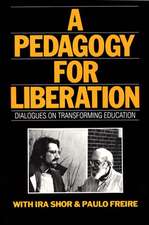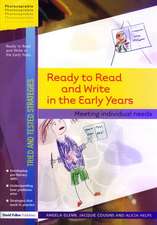Symbolizing and Communicating in Mathematics Classrooms: Perspectives on Discourse, Tools, and Instructional Design
Editat de Paul Cobb, Erna Yackel, Kay McClainen Limba Engleză Paperback – 2000
The book is intended for those who are seeking to expand their understanding of the complexity of learning in order to enhance the learning experiences students have in schools, primarily researchers, instructional designers, and graduate students in mathematics education, as well as those in other fields including science education, instructional design in general, discourse theory, and semiotics.
| Toate formatele și edițiile | Preț | Express |
|---|---|---|
| Paperback (1) | 447.16 lei 6-8 săpt. | |
| Taylor & Francis – 2000 | 447.16 lei 6-8 săpt. | |
| Hardback (1) | 1012.89 lei 6-8 săpt. | |
| Taylor & Francis – 2000 | 1012.89 lei 6-8 săpt. |
Preț: 447.16 lei
Preț vechi: 526.07 lei
-15% Nou
Puncte Express: 671
Preț estimativ în valută:
85.56€ • 89.33$ • 70.81£
85.56€ • 89.33$ • 70.81£
Carte tipărită la comandă
Livrare economică 04-18 aprilie
Preluare comenzi: 021 569.72.76
Specificații
ISBN-13: 9780805829761
ISBN-10: 0805829768
Pagini: 412
Dimensiuni: 152 x 229 x 26 mm
Greutate: 0.54 kg
Ediția:1
Editura: Taylor & Francis
Colecția Routledge
Locul publicării:Oxford, United Kingdom
ISBN-10: 0805829768
Pagini: 412
Dimensiuni: 152 x 229 x 26 mm
Greutate: 0.54 kg
Ediția:1
Editura: Taylor & Francis
Colecția Routledge
Locul publicării:Oxford, United Kingdom
Public țintă
ProfessionalCuprins
Contents: E. Yackel, P. Cobb, K. McClain, Preface. E. Yackel, Introduction: Perspectives on Semiotics and Instructional Design. Part I:Theoretical Considerations. P. Cobb, From Representations to Symoblizing: Introductory Comments on Semiotics and Mathematical Learning. A. Sfard, Symbolizing Mathematical Reality Into Being--Or How Mathematical Discourse and Mathematical Objects Create Each Other. W. Dörfler, Means for Meaning. B. van Oers, The Appropriation of Mathematical Symbols: A Psychosemiotic Approach to Mathematics Learning. R. Nemirovsky, S. Monk, "If You Look at It the Other Way...": An Exploration Into the Nature of Symbolizing. Part II:Instructional Design Issues Related to Symbolizing, Communicating, and Mathematizing. K. Gravemeijer, P. Cobb, J. Bowers, J. Whitenack, Symbolizing, Modeling, and Instructional Design. J. Bransford, L. Zech, D. Schwarts, B. Barron, N. Vye, The Cognition and Technology Group at Vanderbilt, Designs for Environments That Invite and Sustain Mathematical Thinking. R. Lehrer, L. Schauble, S. Carpenter, D. Penner, The Innerrelated Development of Inscriptions and Conceptual Understanding. R. Lesh, H.M. Doerr, Symbolizing, Communicating, and Mathematizing: Key Components of Models and Modeling. J. Bowers, Postscript: Integrating Themes on Discourse and Design.
Recenzii
"All the articles taken together add up to a strong argument in favor of making symbolizing and communicating prominent features in mathematics classrooms. Arguments are well illustrated....A good resource for teacher educators and graduate students who are interested in the interrelationship between semiotic theories and mathematical understanding."
—CHOICE
"...offers literacy educators another way to view mathematics....ways to think about literacy in mathematics classrooms....[and] provides literacy researchers insights into the kind of questions that are important to mathematics education researchers, which can be helpful as literacy educators work to consider problems and questions that cross educational domains....This book ultimately offers to literacy educators an insight into terms like symbolizing, modeling, mathematizing, and representation as used by mathematics educators. By understanding these terms and considering the implications for instructional design, literacy educators can begin building bridges between themselves and mathematics educators."
—Journal of Literacy Research
—CHOICE
"...offers literacy educators another way to view mathematics....ways to think about literacy in mathematics classrooms....[and] provides literacy researchers insights into the kind of questions that are important to mathematics education researchers, which can be helpful as literacy educators work to consider problems and questions that cross educational domains....This book ultimately offers to literacy educators an insight into terms like symbolizing, modeling, mathematizing, and representation as used by mathematics educators. By understanding these terms and considering the implications for instructional design, literacy educators can begin building bridges between themselves and mathematics educators."
—Journal of Literacy Research
Notă biografică
Paul Cobb, Erna Yackel, Kay McClain









